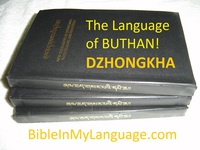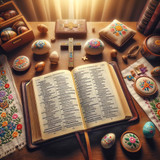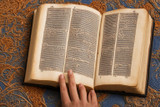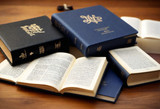Dzongkha New Testament and Bible arrival, we are excited to add to our stock the Scriptures in the language of Bhutan
Dzongkha New Testament and Bible
Extremely RARE Scriptures! Just arrived with our missionaries that visited Bhutan.
Dzongkha (རྫོང་ཁ་; Wylie: rdzong-kha, Roman Dzongkha: Dzongkha), occasionally Ngalopkha ("language of the Ngalop people"), is the national language of Bhutan. The word "dzongkha" means the language (kha) spoken in the dzong "fortresses"—the fortress-like dzong architecture characterises monasteries established throughout Bhutan by its unifier, Ngawang Namgyal, 1st Zhabdrung Rinpoche, in the 17th century.

Dzongkha is usually written in Bhutanese forms of the Uchen script forms of the Tibetan alphabet known as Jôyi (Wylie: mgyogs yig) "cursive longhand" and Jôtshum (Wylie: mgyogs tshugs ma) "formal longhand". The print form is known simply as Tshûm (Wylie:tshugs ma).
Language Data
- Alternate names: Bhotia of Bhutan, Bhotia of Dukpa, Bhutanese, Drukha, Drukke, Dukpa, Jonkha, Rdzongkha, Zongkhar; Also, in India: Drukpa, Hloka, Lhoskad; in Nepal: Bhutanese, Drukha, Drukke, Jonkha, Zongkhar
- Dialects:Adap, Ha, Northern Thimphu, Thimphu-Punakha, Wang-The
- Scriptures published:
- Bible (2010)
- New Testament (2000 — 2007)
- Portions (1970)
- Literacy: Literacy rate in first language: 54% in Dzongkha. Literacy rate in second language(s): Below 5%. Taught in primary schools, Common school language
Second Language: No information available. - Primary country: Bhutan
- Region: Ha, Paru, Punakha, and Wangdue Phodrang districts
- Also used in: India, Nepal
- Religion: Buddhist
- Status: Statutory national language in Bhutan
- Number of users: 237,080 (160,000 in Bhutan (2006); 11,000 in India (2007); 300)
- Vitality: National
EXPLORE POPULAR ARTICLES
A Tapestry of Scriptures: Discovering Diverse Bibles from Around the World
A Tapestry of Scriptures: Discovering Diverse Bibles from Around the WorldIn a quiet corner of the...
A Tapestry of Devotion - Diverse Bibles for a Global Congregation
A Tapestry of Devotion - Diverse Bibles for a Global CongregationIn a world rich with cultural and l...
Unveiling the Sacred: A Literary Journey Through BIML's Hungarian Bibles
Unveiling the Sacred: A Literary Journey Through BIML's Hungarian BiblesIn the vast mosaic of langua...
An Ode to the Sacred Texts: A Multilingual Journey Through the Bible's Many Tongues
An Ode to the Sacred Texts: A Multilingual Journey Through the Bible's Many TonguesIn the great tape...
Exploring Scripture Across Cultures: The Beauty of Multilingual Bibles
Exploring Scripture Across Cultures: The Beauty of Multilingual BiblesIn a world brimming with a m...
The Profound Resonance of Multilingual Bibles: A Tapestry of Faith Across Languages
The Profound Resonance of Multilingual Bibles: A Tapestry of Faith Across LanguagesIn the intricate...






